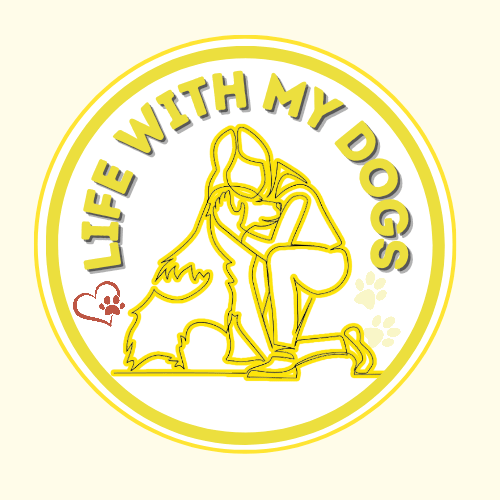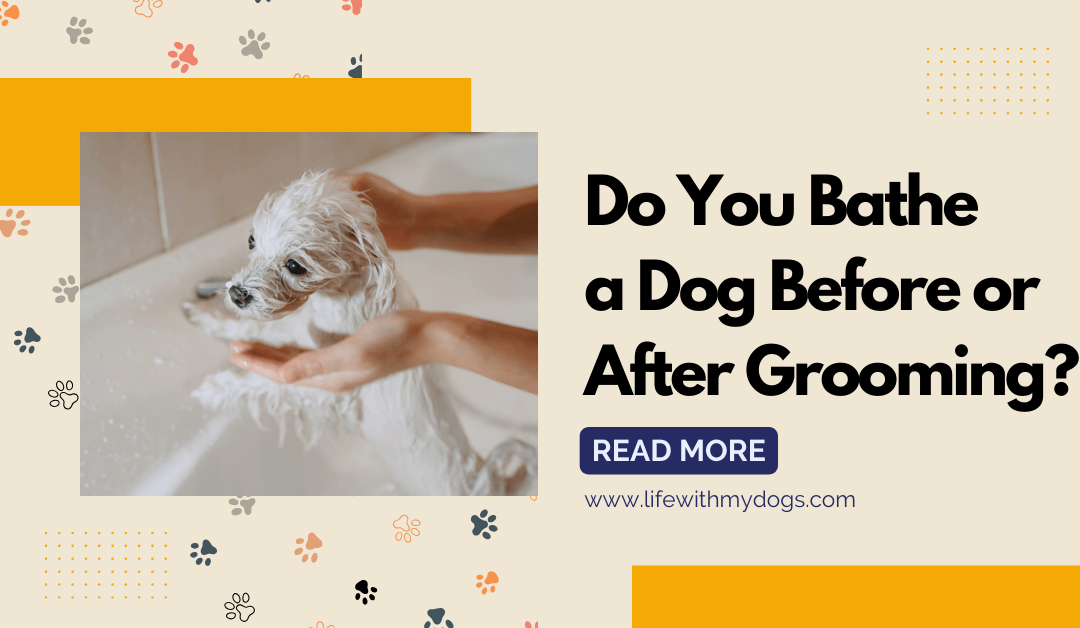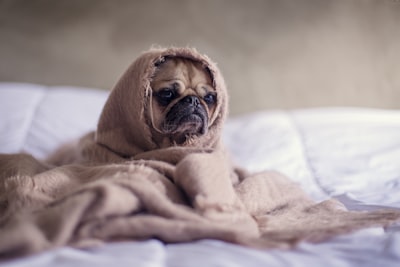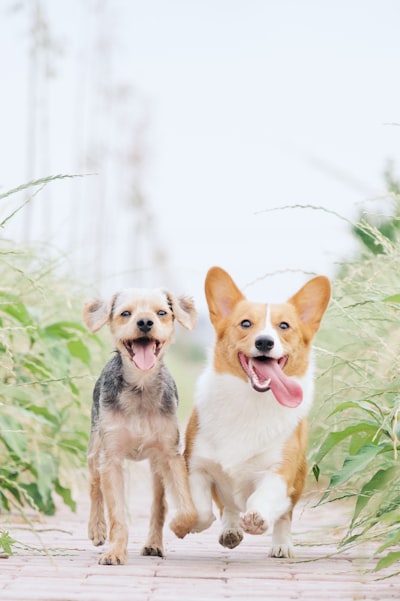LifeWithMyDogs is supported by our audience. When you purchase through one of our links, we may earn a small affiliate commission. As an Amazon Associate I earn from qualifying purchases. Your cost is not affected.
**********
Some people think they need to get the dog’s grooming completed before the wash. Do you bathe a dog before or after grooming? As a professional groomer, I know the temptation to get the most coat off the dog before bathing. But that isn’t always the right option. My clippers and scissors appreciate me taking the time to get my dogs clean before beginning the trim.
Do You Bathe a Dog Before or After Grooming?
Your furry friend deserves the best care, and that includes regular grooming. But when it comes to bathing your dog, you might be wondering whether it’s best to do it before or after grooming. Both approaches have advantages and disadvantages, and ultimately, the decision depends on a few factors.
In this post, we will explore the entire grooming process and talk about why regular grooming is important for your dog’s health and well-being. We will dive deep into the pros and cons of pre-grooming baths versus post-grooming baths, including guidelines on proper dog bathing techniques and essential grooming practices. Finally, we will discuss common mistakes in dog grooming and how to avoid them. Whether you’re a new pet owner or an experienced one looking for some expert advice, this post has got you covered!
Understanding the Grooming Process
Regular grooming keeps a dog’s coat, skin, and nails healthy. It involves brushing, washing, clipping, and grooming a dog’s fur, nails, ears, teeth, and eyes. This process helps remove loose hair, knots, tangles, mats, dirt, and debris. Professional groomers have expertise in different coat types. Regular grooming ensures a comfortable, clean, and happy furry friend.
The Importance of Regular Grooming for Dogs
Regular grooming is essential for dogs as it helps prevent skin problems, irritation, and discomfort. Brushing their hair regularly maintains a mat-free coat. Bathing removes excess dirt, oils, and loose hair, promoting a healthy coat. Regular grooming sessions also aid in the early detection of skin conditions or abnormalities while enhancing their overall hygiene and appearance.
Major Steps in a Typical Dog Grooming Session
A typical dog grooming session involves several important steps for the dog’s overall well-being. These steps include brushing the fur, bathing, drying, and grooming the fur, nails, ears, teeth, and eyes of the dog.
Should You Bathe Your Dog Before or After a Haircut?
Depending on the breed or coat type, clipping or trimming of the fur may also be necessary. Professional groomers use specialized tools, such as scissors, clippers, conditioners, and shampoos, tailored to the specific needs of dogs.
After the grooming session, brush the dog’s coat again. Now cut the hair, trim the nails, recheck the ears, brush the teeth, and recheck the eyes to clear any last-minute debris. It is important to create a positive and stress-free environment during the grooming session to ensure a calm and enjoyable experience for the dog.
To Bathe or Not to Bathe Before Grooming?
Deciding whether to bathe your dog before grooming is a personal choice. However, bathing can remove dirt and make the grooming process easier. It also helps identify any skin conditions or tangles. Just be sure to use a dog-friendly shampoo.
Advantages of Bathing Your Dog Before Grooming
Bathing a dog before grooming allows groomers to identify any mats, tangles, or skin conditions beforehand. It also ensures a clean dog, making the grooming process easier and more hygienic.
Brushing wet fur after bathing helps remove loose hair, knots, and tangles, minimizing discomfort during grooming. Additionally, a clean coat allows groomers to achieve a professional, groomed look after clipping or trimming.
Bathing before grooming removes excess dirt and debris, making the dog’s coat easier to work with.
Pro Tip: Waiting to clip or trim hair until after the dog is clean and dry helps keep those expensive clipper blades and scissors sharp a lot longer! Professional groomers always choose to wash the dog first. It helps save equipment and is easier on the dog, too.
Potential Drawbacks of Pre-Grooming Bath
While bathing a dog before a grooming session usually proves beneficial, there are some potential drawbacks to consider. For example, it may dry out the dog’s skin if not followed by conditioner or appropriate grooming techniques.
Additionally, certain coat types, like long hair or specific breeds, may tangle or mat after bathing. This makes the grooming process more challenging. Groomers should also be cautious of over-washing, as it can strip natural oils and lead to dry skin or coat problems.
Dogs with skin conditions should be bathed under veterinary guidance, and first-time puppies may find the bathing process overwhelming, causing discomfort or anxiety before grooming.
Bathing After Grooming: Pros and Cons
Bathing a dog after grooming can leave their coat clean and fresh, washing away loose hair, clippings, and debris. It helps achieve a professional, groomed look and allows groomers to rinse off excess grooming products.
Bathing after grooming can minimize discomfort for dogs with sensitive skin or coat. It is important to follow professional guidance and use dog-friendly techniques.
Benefits of Post-Grooming Bath for Your Dog
Post-grooming bath washes off excess products, leaving a clean, fresh, and odor-free coat. It helps groomers achieve a professional look by removing loose hair and debris. The bath soothes the skin, maintains hygiene, and ensures overall well-being. It should be a positive, stress-free experience for the dog’s comfort.
Reasons Some Prefer Not to Bathe After Grooming
Some dog groomers prefer to skip the post-grooming bath, especially for dogs with sensitive or dry skin. Wet fur after bathing can cause discomfort or matting, particularly in long-haired breeds.
Not all coat types or breed standards require a bath after grooming. Professional techniques and products leave little debris. For dogs with skin conditions, bathing should be done under veterinary guidance. Groomers should discuss bathing preferences based on each dog’s coat, skin, and breed.
Guidelines for Proper Dog Bathing
- When bathing your dog, it’s important to use a dog-friendly shampoo and conditioner that is suitable for their specific coat type, breed, or skin conditions.
- Before bathing, make sure to brush or comb their fur to remove any loose hair, knots, or tangles. Wet their entire coat thoroughly, excluding the head and ears, before applying shampoo, conditioner, or grooming oils.
- After bathing, rinse their coat, paws, nails, teeth, eyes, and ears thoroughly to eliminate any shampoo or conditioner residue and prevent irritation.
- Finally, dry their coat using a grooming dryer or towel to ensure their comfort and prevent moisture or itchiness.
Techniques for Making Bath Time Calm and Effective
Introduce your dog gradually to bath time, starting with short positive experiences.
- Use treats or toys to create a positive and rewarding environment.
- Maintain a calm and soothing tone of voice to help relax your dog.
- Prevent slipping by using a non-slip mat or towel in the bathtub.
- Consider grooming your dog before bathing to remove loose hair and mats.
Essential Grooming Practices
Regular grooming is essential to maintain your dog’s healthy coat and skin.
- Brushing their fur helps remove loose hair, tangles, and distributes natural oils.
- Use the right brush for the dog’s coat type.
- Trimming their nails regularly prevents discomfort or injury.
- It’s also important to clean their ears, teeth, and eyes as part of a routine.
Brushing: The Key to a Healthy, Tangle-Free Coat
Regular brushing sessions for your dog’s coat are essential in maintaining a healthy, tangle-free coat. It helps distribute natural oils, preventing tangles and mats. Use a slicker brush or pin brush for long-haired dogs and a bristle brush for short-haired ones. Brushing stimulates blood flow, promotes healthy skin, and removes debris. Bond with your dog while also identifying potential skin or coat issues early on.
Trimming Hair and Nails: Safety and Comfort
Ensuring your dog’s safety and comfort is crucial when trimming their hair and nails. Use sharp, high-quality tools to make the process easier and less stressful. Trim at a comfortable pace and stop if your dog seems uncomfortable. Reward them with treats and praise throughout. Regular grooming promotes healthy skin and prevents issues like matting.
Grooming Different Breeds: What You Need to Know
Different dog breeds have different grooming requirements. While short-haired breeds may not need as much grooming, regular grooming is important for all dogs to maintain a healthy, shiny coat. And many short-haired dogs shed as much or more as those with longer coats. It’s crucial to pay attention to your dog’s individual needs, such as trimming nails and cleaning ears.
Grooming Needs for Long-Haired Breeds
Long-haired breeds require regular grooming to prevent the tangling and matting of their fur. Bathing before grooming makes the hair easier to manage and cut. Meanwhile, bathing afterward removes loose fur and debris.
Long-haired dogs benefit from line brushing rather than just brushing over the top of the coat. Getting down to the skin helps stimulate the skin and the hair. Use the right shampoo and conditioner for your dog’s coat type. Regular brushing and trimming also aid in maintaining your dog’s coat and overall hygiene.
Short-Haired Breeds: Less Grooming, More Bathing?
Short-haired breeds require less grooming but still need regular baths. Frequent bathing keeps them clean and reduces shedding. However, be cautious of over-bathing as it can strip their coat of natural oils, leading to dry skin.
Common Mistakes in Dog Grooming and How to Avoid Them
When it comes to grooming your dog, there are some common mistakes you should avoid. One mistake is bathing your dog before grooming, as it can cause matting and tangling of the fur. Additionally, grooming a dirty dog can lead to skin irritation and discomfort. It’s important to avoid over- or under-brushing. This can also cause matting and discomfort. Neglecting to trim your dog’s nails can result in painful ingrown nails, and skipping regular grooming appointments can lead to health and hygiene issues for your dog.
Being aware of these mistakes and taking preventive measures can ensure a positive grooming experience for your furry friend.
Overbathing: Is There Such a Thing?
Overbathing dogs can have negative effects on a dog’s skin and coat. The frequency of bathing should depend on the breed and activity level of the dog. Generally, it is recommended not to bathe dogs more than once a month to avoid dry, itchy skin and a dull coat.
Is it Better to Bathe a Dog Before or After Grooming?
Bathing your dog before grooming has its advantages. It ensures a clean coat, making it easier for groomers to work with. Additionally, it allows groomers to assess your dog’s skin and coat type more effectively. Regular pre-grooming baths prevent loose hair and tangles, keeping your furry friend looking and smelling fresh.
Do You Bathe a Dog Before Grooming?
Whether you bathe your dog before or after grooming depends on various factors, such as your dog’s coat type and preference. Bathing before grooming helps remove dirt and tangles, making the grooming process easier and more effective. It also results in a cleaner and more polished finish. On the other hand, bathing after grooming can help remove any loose hair or residual grooming products, leaving your dog feeling fresh and clean. Ultimately, the decision is yours to make based on what works best for you and your furry friend. Remember to prioritize your dog’s comfort and well-being throughout grooming.
Frequently Asked Questions
How often should I bathe my dog if they are regularly groomed?
What are the benefits of bathing a dog before grooming?
Why should you brush your dog before bathing?
- It helps remove loose hair, dirt, and mats from their coat while distributing natural oils to keep them healthy and shiny.
- Additionally, brushing before bathing allows shampoo to penetrate deeper, ensuring a more effective clean.
- Regular brushing also prevents matting and tangling, making grooming sessions easier for your furry friend.
Why should you clip your dog after bathing?
Learn More About Dog Care!
Discover essential dog care tips with us and more. Join our Facebook, Instagram, and Twitter for practical advice, real stories, and a community focused on better dog care.
Facebook: https://www.facebook.com/1LWMD/
Instagram: http://instagram.com/lifewithmydogs2
Twitter : https://twitter.com/LifeWithMyDogs9
Learn more tips about dog care and more with us – where every dog’s health is a priority.














